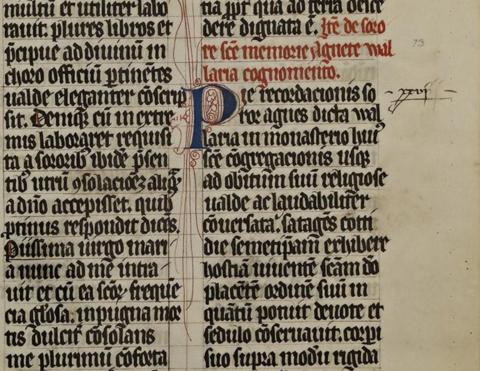Regarding Sister Agnes Waller of Blessed Memory | Item de sorore sancte memorie Agnete, Wallaria cognomento
Introduction to the Text
“Regarding Sister Agnes Waller of Blessed Memory” is one of several spiritual biographies written by, for, and about the late-medieval nuns of the Dominican monastery of Unterlinden (or Sub tilia in Latin) in their book of Vitae sororum (“Lives of sisters”). The monastery of Unterlinden was founded in the mid-13th century, in the town of Colmar, Alsace (today’s France; a German-speaking region in the Middle Ages).
The Unterlinden Vitae sororum belongs to the late-medieval genre of Sisterbooks (also known as Schwesternbücher, Nonnenbücher, or Convent Chronicles). These are collections of spiritual biographies, similar to saints’ lives (a.k.a. vitae), recording the lives and devotions of the community’s sisters. They were usually collectively authored by the nuns, in either Latin or a Middle High German dialect regional to the monastery, and updated over subsequent generations. The Unterlinden Vitae sororum was probably composed between the late 13th and early 14th centuries.
The entry concerning Sister Agnes Waller is typical of this genre, and particularly notable for its focus on affective piety and the Eucharist. The author of Sister Agnes’s entry praises her holy way of living, calls her a “living sacrifice” and “devoted servant” of the divine, and describes her as “betrothed to God” even before she enters the monastery. At the point of taking her vows, Sister Agnes renounces the secular world and experiences a divine feeling so overwhelming that she begins spontaneously bleeding from her mouth and nostrils. Another miracle happens to Sister Agnes in the monastery: during the celebration of the Mass, she receives a vision of Christ as a beautiful child, white in body and surrounded by red “like an infant newly born.” The author presents Sister Agnes as an example of complete renunciation of the world in favour of a life dedicated to God. Both of the visions attributed to her show the focus on the Eucharist and the humanity of Christ which was common in late-medieval women’s devotion across Europe.
Introduction to the Source
The Unterlinden Vitae sororum was produced at the monastery of Unterlinden (Colmar, Alsace), between the late 13th and early 14th centuries. It comes down to us in a 15th-century copy held at the Bibliothèque municipale in Colmar (MS. 508). There is also a fragmentary copy held in Paris (Cod. lat. 5642 in the Bibliothèque nationale de France) and a translation of the Vitae sororum into Middle High German, dated to the 15th century, which exists in at least two copies (Cod. 164.1 Extravagantes in the Wolfenbüttel Herzog-August-Bibliothek; MS. MA59 in the archive of St Katherine’s Dominican monastery at Zöffingen). The existence of multiple copies of this manuscript and its translations, indicates that the lives of the sisters of Unterlinden were transmitted to other monasteries as well.
The Unterlinden Vitae sororum offers a good example of the type of collective authorship typical of Sisterbooks. After the first 37 chapters, there is an addition of three more under the heading “Regarding those neglected and omitted above” (De omissis superius et neglectis) followed by a note that “I, Sister Catherine, raised in this monastery from childhood, completed this work” (Explicit liber. Ego soror Katharina in eodem monasterio a puericia enutrita hoc opus exegi. Summo sit gloria regi.). Five more chapters describing the lives of Unterlinden nuns then follow.
About this Edition
This new translation is based on Jeanne Ancelet-Hustache’s 1930 edition of the Vitae sororum, which is available on JSTOR. The full manuscript is also available, digitized, on the website of the Bibliothèque municipale de Colmar.
Further Reading
Ancelet-Hustache, Jeanne, editor. “Les ‘Vitae sororum’ d’Unterlinden: Édition critique du manuscrit 508 de la bibliothèque de Colmar.” Archives d’histoire doctrinale et littèraire du Moyen Âge vol. 5, 1930, pp. 317–513.
Cails, Sœur Élie. Un monastère dominicain au Moyen ge: les débuts d’Unterlinden. Éditions du cerf, 2013.
DeMaris, Sarah Glenn. “Anna Muntprat's Legacy for the Zöffingen Sisters: A Second Copy of the Unterlinden Schwesternbuch.” Zeitschrift für deutsches Altertum und Literatur, vol. 144, 2015, pp. 359–378.
Geith, Karl-Ernst. “Heiligenverehrung und Hagiographie im Kloster Unterlinden zu Colmar.” Dominicains et dominicaines en Alsace, XIIIe-XXe siècles, edited by Jean-Luc Eichenlaub. Conseil général du Haut-Rhin, 1996, pp. 167-172.
Les dominicaines d’Unterlinden: publié à l’occasion de l’exposition Les dominicaines d’Unterlinden, edited by Madeleine Blondel, Jeffrey Hamburger, Catherine Leroy, 2 vols. Musée d'Unterlinden, 2000–2001.
Lewis, Gertrud Jaron. By Women, for Women, about Women: the Sister-Books of Fourteenth-century Germany. Pontifical Institute of Mediaeval Studies, 1996.
Lindgren, Erika Lauren. “Searching for Women in the Records of Women: Two Examples from the South German Dominicans.” Church History and Religious Culture, vol. 88, no. 4, 2008, pp. 563–580.
Winston-Allen, Anne. Convent Chronicles: Women Writing about Women and Reform in the Late Middle Ages. Pennsylvania State UP, 2004.
Credits
Transcription taken from the edition in “Les ‘Vitae sororum’ d’Unterlinden: Édition critique du manuscrit 508 de la bibliothèque de Colmar”. Ed. Jeanne Ancelet-Hustache. Archives d’histoire doctrinale et littèraire du Moyen Âge vol. 5 (1930): 317–513.Translation by Laura MoncionEncoded in TEI P5 XML by Danny SmithSuggested citation: Various. "Regarding Sister Agnes Waller of Blessed Memory." Trans. Laura Moncion. Global Medieval Sourcebook. http://sourcebook.stanford.edu/text/regarding-sister-agnes-waller-blesse.... Retrieved on April 29, 2024.

